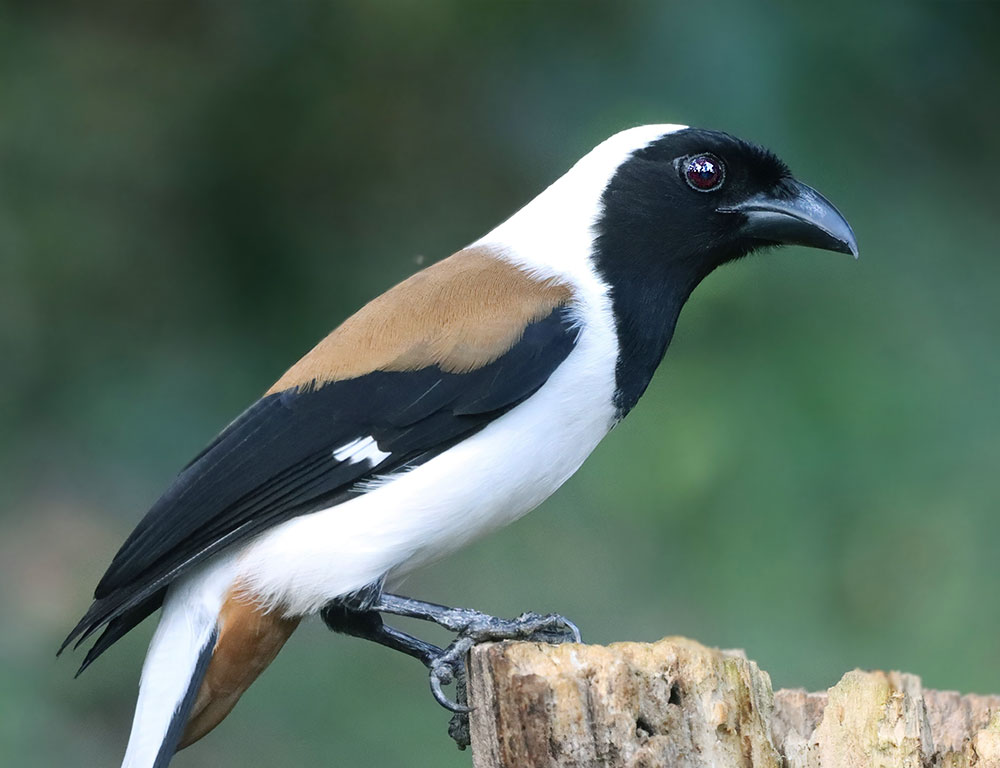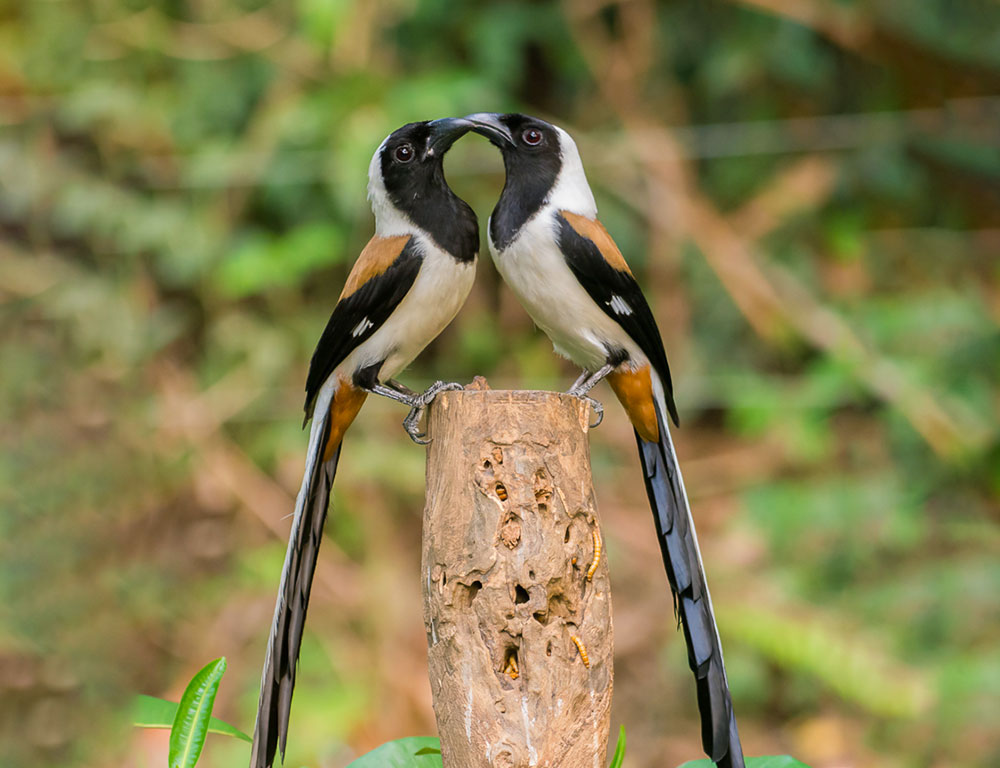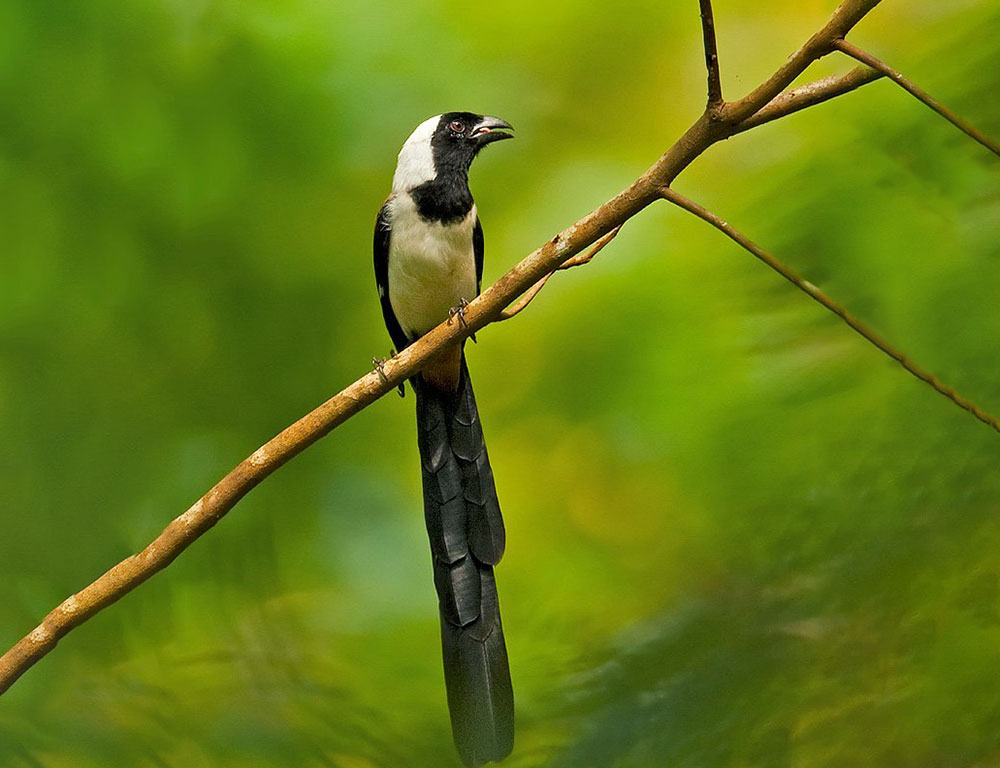When you think of the most fascinating creatures in the avian world, it’s hard to overlook the White-Bellied Treepie. This bird species is unique, not just for its striking appearance but also for its intriguing behavioral patterns.
Native to evergreen forests and scrubs of Southwest India, I’ve always found this bird incredibly captivating. The White-Bellied Treepie is a part of the Corvidae family; that’s right, they’re related to crows and jays.
But what makes them stand out? Their distinctive black-and-white plumage and long tail feathers are enough to turn any head.
As an avid birdwatcher, I can tell you there’s something special about seeing a White-Bellied Treepie in its natural habitat. Their vibrant colors, contrasting with the greenery of their surroundings, create a sight that’s truly worth cherishing.
Physical Characteristics of the White-Bellied Treepie

The White-Bellied Treepie indeed possesses a remarkable set of physical characteristics that distinguish it in the avian world.
Here’s a summary of its notable features:
Size
Adults of the White-Bellied Treepie species are relatively large, measuring between 48 and 60 cm in length. This size places them among the more prominent members of the treepie family, contributing to their presence in their forest habitat.
Coloration
One of the most striking features of the White-Bellied Treepie is its distinctive coloration. Its head, neck, and chest are adorned with glossy black plumage, creating a bold contrast against the whitish-grey belly that gives the bird its name.
This eye-catching coloration makes it easily recognizable in its forest environment.
Tail
The treepie’s long tail feathers are adorned with intricate white and black barred patterns. These patterns enhance the bird’s visual appeal and serve practical purposes, possibly aiding communication, balance, and flight control.
Bill
Equipped with a stout and slightly curved bill, the White-Bellied Treepie is a formidable foraging tool. Its strong bill is well-suited for scooping insects or small reptiles from tree surfaces, showcasing the bird’s adaptability and hunting prowess.
Eyes
Deep brown eyes provide the White-Bellied Treepie with sharp vision, essential for detecting prey and navigating its forest habitat. This keen eyesight and other sensory abilities make it an efficient hunter and adept navigator.
Wings
Rounded wings enable the White-Bellied Treepie to maneuver swiftly through dense forest canopies. This agility is essential for pursuing prey, evading predators, and navigating its habitat’s complex and varied terrain.
Habitat and Distribution of the White-Bellied Treepie

The White-Bellied Treepie, native to the lush forests of South India, particularly the Western Ghats region, occupies a specific ecological niche.
Here’s a breakdown of its habitat and distribution:
Habitat
White-Bellied Treepies primarily inhabit the tropical evergreen and moist deciduous forests of the Western Ghats. These forests offer an ideal environment with dense canopy cover for nesting and open spaces for their acrobatic flight displays.
Distribution
The distribution range of the White-Bellied Treepie is relatively narrow, mainly concentrated in parts of Kerala and Tamil Nadu states in South India. They are found across forested hill ranges at varying altitudes, from sea level up to approximately 1400 meters.
Territoriality and Migration
White-Bellied Treepies exhibit assertive territorial behavior and do not undertake significant migrations. They maintain a stronghold over their territories within the Western Ghats.
Dietary Preferences and Habitat Choice
Being omnivorous, White-Bellied Treepies have varied dietary preferences, including fruits, insects, small reptiles, and eggs from other birds’ nests.
The diverse flora and fauna of the Western Ghats cater well to their eclectic palate, making these forests an ideal habitat choice.
Population Estimates and Conservation Status
Data on White-Bellied Treepie populations are scarce due to their limited distribution. However, BirdLife International estimated a population of 10,000 to 20,000 individuals in 2017.
Despite being classified as ‘Least Concern’ by the IUCN Red List (as of May 2021), their populations are declining due to habitat loss caused by logging and land conversion for agriculture.
Behavior and Diet of the White-Bellied Treepie

The behavior and diet of the White-Bellied Treepie offer fascinating insights into its lifestyle and ecological role.
Here’s a closer look at its behavior and dietary preferences:
Social Behavior
White-Bellied Treepies are social birds, often observed in small groups or flocks as they move through the forest canopy. This social behavior facilitates communication and cooperative foraging, potentially enhancing predator detection and defense.
Feeding Behavior
- Diet Composition: Their diet primarily consists of fruits (70%), insects (25%), and small reptiles (5%). This diverse diet reflects their omnivorous nature and adaptability to various food sources within their habitat.
- Foraging Strategy: White-Bellied Treepies employ various foraging strategies, including probing foliage and tree bark for hidden insects and pecking at ripe fruits. Their sharp beaks and agile movements enable them to extract food from diverse sources efficiently.
- Feeding Adaptations: These birds demonstrate adaptability and resourcefulness in their feeding behavior. They may hold more oversized food items with their feet while using their beaks to tear into them, showcasing their skill and ability to exploit different food resources.
Breeding Behavior
- Breeding Season: Breeding typically occurs between February and April, during which males engage in vocalizations and courtship displays to attract females.
- Nesting and Incubation: After mating, female treepies lay clutches of 3-4 eggs, which are then incubated for approximately two weeks. The nesting process and parental care behaviors contribute to the survival and reproductive success of the species.
Conservation Status of the White-Bellied Treepie

The conservation status of the White-Bellied Treepie is classified as “Near Threatened” by the International Union for Conservation of Nature (IUCN).
This designation indicates that while the species is not currently facing the immediate risk of extinction, it is experiencing population declines and faces potential threats that could lead to a higher risk status if proactive measures are not taken.
Several factors contribute to the threats faced by the White-Bellied Treepie:
Habitat Loss
Rapid urbanization and deforestation have significantly reduced the available habitat for these birds, leading to a decline in their population.
Hunting and Trapping
Despite legal protections, the White-Bellied Treepie is still subject to hunting and trapping for various reasons, including the pet trade, food, and sport. Inadequate enforcement of laws contributes to this threat.
Conservation efforts are underway to mitigate these threats and protect the White-Bellied Treepie:
Habitat Protection
Initiatives are aimed at conserving and restoring the habitats vital for the survival of these birds. This includes measures to prevent further deforestation and habitat destruction.
Strengthening Laws and Enforcement
There is a push for stricter enforcement of laws against hunting and trapping the White-Bellied Treepie, along with advocacy for increased offender penalties.
Education and Awareness
Public outreach and education programs are being implemented to raise awareness about the importance of wildlife conservation and the threats the White-Bellied Treepie faces.
These efforts aim to foster a sense of stewardship among local communities and encourage conservation actions.
Let’s talk numbers now:
| Year | Estimated Population |
|---|---|
| 2008 | 10,000-20,000 |
| 2018 | Less than 10,000 |
Conclusion
I’ve spent considerable time exploring the White-Bellied Treepie world, and I’m genuinely fascinated by this unique bird species. Their distinctive features, behavior, and habitat have interested me throughout this journey.
With their white underparts and dark upper bodies, these birds are not just beautiful but also quite distinct in their appearance. They’re real standouts in the avian world. It’s been intriguing to delve into their behavioral patterns, too.
From their diet consisting mainly of fruits and insects to their ability to adapt to different environments – it’s all genuinely fascinating.
What struck me most about these birds is their resilience. Despite having a limited geographical range, primarily in Southern India, they’ve adapted well to changing conditions.
The White-Bellied Treepie thrives amidst human settlements and dense forests, showcasing its incredible adaptability.
However, we can’t overlook the challenges they face either:
- Habitat loss due to deforestation
- Potential threats from predators
- Limited genetic diversity due to confined population
These hurdles make it crucial for us humans to play our part in ensuring their survival.
In terms of conservation efforts for these birds, it becomes essential that we focus on maintaining their natural habitats while also regulating activities that could potentially harm them or disrupt their peaceful existence.
In closing, my exploration has led me down an enlightening path where I’ve learned so much about the captivating White-Bellied Treepie. It’s reinforced my belief that every creature is integral to our ecosystem and warrants our respect and protection.